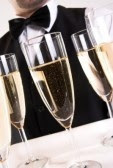 From the "Dowd On Drinks" archives, updated:
From the "Dowd On Drinks" archives, updated:
Flash forward to December 26. There you sit, in your latest ugly Christmas sweater that already has a splotch of holiday gravy on the front, wondering how to avoid looking like a schlub when you uncork the champagne you've been assigned to purchase for the next family inquisition commonly known as New Year's Eve.
You like your bubbly, of course, if it says Bud Lite on the label. What do you know about that frou-frou French stuff, and who wants to spend that kind of money on something that tickles your nose and tastes sour anyway?
If you know champagne is French, you may be farther ahead than you realize. The rest is a simple matter of getting educated. Quickly. So, let's take you back in time to just before Thanksgiving 2011 -- like today, maybe. Sit up straight and pay attention.
True champagne comes from the Champagne region in the northeastern part of France which jealously protects the name "Champagne'' worldwide. That's why the phrases "Champagne style'' and "methode champenoise'' appear on a lot of non-French labels. (See how much you've learned already?)
Champagne doesn't taste sour. Crappy Champagne does. However, it does have quite a range from tart to sweet.
There is something called "liqueur d'expedition'' which is used to top off bottles after the sediment has been removed. Because it contains varying amounts of sugar and some reserve wine, the sweetness of the finished product will vary and determines the style of the Champagne.
The most common style is brut -- there is an extra or ultra brut, but you'll rarely see it, especially in the U.S. Brut has 0 to 15 grams of sugar per liter. Then comes extra sec with 12-20 grams, sec at 17-35, demi-sec at 35-50, doux at more than 50 and also extremely rare. You're usually dealing with brut style in this country, and it's a versatile wine for meals, desserts or just quaffing.
Champagne prices range all over the place, such as $15-$22 for a palatable low-end wine to $30-$60 for the better ones without having to sell your first-born to pay for even more expensive ones. My favorites are Veuve Clicquot Ponsardin ($39.95) and Piper-Heidsieck Champagne Brut ($30) among the affordable imports and Chateau Frank 2000 Blanc de Noirs from the Finger Lakes ($29.99) among the "methode champenoise'' domestics.
What should determine the price is what's in the bottle. A non-vintage wine, usually denoted by the letters NV on the label instead of a vintage year, is a blend from several different years. Vintage wines are produced from a single year. Most Champagne houses will designate a vintage only if they think the grape crop from that year was special. Otherwise, they blend their product to meet a certain standard. Vintages are more expensive.
Some of the other top-tier French Champagnes are Taittinger, Moet et Chandon, Bollinger, Cristal, Pol Roger and Dom Perignon. The French-owned Roederer Estate winery in California also produces some nice bubblies.
Champagnes do not have to be golden, as the movies would have you believe. There are Champagnes ranging in color from nearly white to deep gold to rose or bright pink. It all depends on the manufacturing process.
There are Champagnes made entirely from black grapes (blanc de noir) such as pinot noir and pinot meunier and Champagnes made entirely from white grapes (blanc de blanc) such as chardonnay. The rose wines are made by allowing a little more contact with the red grape skins than usual or, in a few cases, even introducing a touch of red wine to the process.
Champagne is best served as cold as you can get it without putting it in the freezer, although that can be strictly a matter of individual taste. The coldness helps maintain the bubbles after opening.
And, speaking of opening, a bad job of doing that can ruin the whole thing. Just keep a few things in mind:
• Remove the wire cage and foil covering the cork.
• Point the bottle away from everyone, including yourself. It is under tremendous pressure, so it can be a dangerous missile.
• Put a dish towel over the top of the bottle and, with your hand under the towel, grasp the cork firmly.
• Hold the cork steady and turn the bottle. The cork will slowly disengage.
• When the cork comes out, keep the towel over the bottle opening for a moment to preserve the gas and the Champagne.
• Pour into Champagne flutes and enjoy.
To Dowd's Guide to American Wine Trails
To Dowd's Spirits Notebook latest entry.
To Dowd's Tasting Notes latest entry.
To Dowd's Brews Notebook latest entry.
Back to Dowd's Guides home page.










